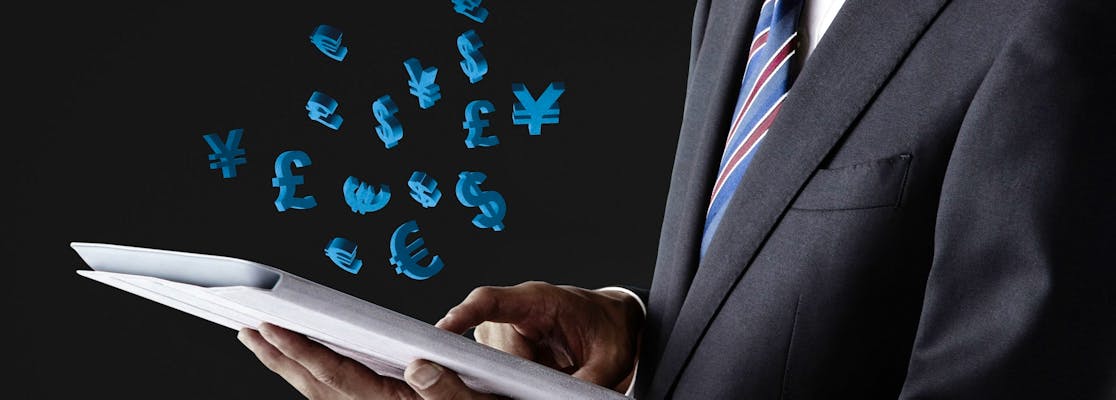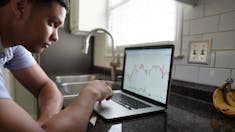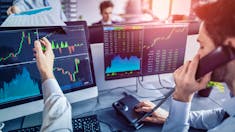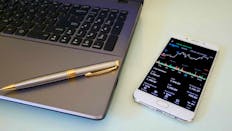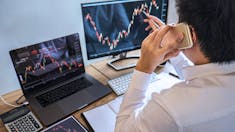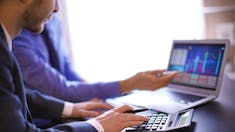Forex Currency Trading For Beginners (2025 Guide)
All products and services featured are independently selected by WikiJob. When you register or purchase through links on this page, we may earn a commission.
- Best Forex Brokers for Beginners – List for January 2025
- Best Forex Trading Platforms & Brokers for Beginners in the UK – Reviewed (January 2025)
- What Is Forex Currency Trading?
empty
- How Does Forex Currency Trading Work?
- Forex Trading Examples
empty
empty
- Charts Used in Forex Trading
- Types of Forex Markets
empty
empty
- Pros and Cons of Forex Trading
- Forex Trading Risks
- Forex Automated Trading
- How to Become a Forex Trader: Step by Step Guide
- 10 Forex Trading Tips for Beginners
empty
empty
empty
empty
empty
empty
empty
empty
empty
empty
- Beginner Forex Trading Strategies
empty
empty
empty
- Strategies for Experienced Traders in Forex
empty
empty
empty
- What to Consider When Choosing a Forex Strategy
empty
empty
empty
empty
empty
- How to Choose a Forex Trading Broker in 2025
- Frequently Asked Questions
- Final Thoughts
Best Forex Brokers for Beginners – List for January 2025
- One of the high leverage CFD brokers: Plus500
- Best for beginners looking for a user-friendly trading platform: Spreadex
- Best trading platform UK for beginners: eToro
Best Forex Trading Platforms & Brokers for Beginners in the UK – Reviewed (January 2025)
1. Plus500
Pros
- No buy/sell commissions and tight spreads
- Leverage of up to 1:30
- FREE unlimited Demo
- 2,800+ CFD trading instruments
- Real-time quotes and advanced analytical tools
- Fast and reliable order execution
Cons
- No API integrations
- No social copy trading
Plus500 instruments are available for trading exclusively via CFDs and the service offered on the platform is CFD-based.
Plus500 was founded in Israel in 2008; therefore, while it is regulated, it has yet to survive a recession.
The educational resources are not as good as other Forex trading platforms, and the platforms lack when it comes to research and analysis.
It is user-friendly and easy to set up an account, however.
Beginners are always advised to start with a demo account since trading CFDs is a risky activity, Plus500 is not suitable for pure beginners.
2. Spreadex
Pros
- Award-winning mobile app
- Extensive US shares and ETFs
- Extended hours trading available
- Full TradingView integration
- Free Financial Tomes subscription with qualifying deposit
- No minimum deposit required
- No inactivity fees
Cons
- Does not offer MetaTrader 4 (MT4)
- Limited to CFDs and spread bets
- No physical share dealing
Spredex stands out as one of the best forex brokers for beginners due to its comprehensive offerings and user-friendly features.
Its commitment to delivering a top-notch user experience is evidenced by its recognition in the industry, having won awards for the "Best Mobile App" and "Best Platform Reliability."
These accolades underscore its capability to provide a stable and intuitive trading environment that can significantly benefit novice traders.
One of the key advantages for beginners at Spredex is its integration with TradingView, a leading financial visualization platform. This integration allows novice traders to access advanced charting tools and perform technical analysis with ease, a feature that is essential for making informed trading decisions.
The user-friendly interface and robust support system further contribute to a seamless learning curve for those new to forex trading.
Moreover, Spredex offers extensive resources to help beginners get started. For instance, new users who deposit £500 or more receive a free subscription to Financial Tomes, offering a wealth of information that can enhance their understanding of forex markets and trading strategies.
Another significant benefit for beginners is the absence of a minimum deposit requirement and no inactivity fees.
This approach allows new traders to start small and learn at their own pace without the pressure of accumulating costs, making it an ideal platform for those just starting out in forex trading.
While Spredex does not offer physical share dealing or MetaTrader 4 (MT4), its focus on CFDs and spread bets through a user-friendly platform equipped with necessary educational resources makes it a highly suitable choice for beginners looking to enter the forex market.
This specialization ensures that newcomers can focus on learning the intricacies of forex trading without the complexity of additional trading options that might be more suited to experienced traders.
3. eToro
Pros
- Regulated by FCA, ASIC
- 0% commission on stocks
- Social and copy trading
Cons
- More expensive than most of its competitors
- No MetaTrader platforms
Below content does not apply to US users.
eToro is one of the most popular Forex trading platforms.
For beginners, there is very little educational material to guide you, however.
Where eToro does excel as a Forex trading platform for beginners is their social trading, which allows you to copy another trader's portfolio.
The trading platforms are also user-friendly.
To find out more, read our eToro review.
61% of retail investor accounts lose money when trading CFDs with eToro. You should consider whether you understand how CFDs work, and whether you can afford to take the high risk of losing your money.
What Is Forex Currency Trading?
Forex (foreign exchange), or FX, is the process of swapping one currency for another currency. People trade forex for many different reasons, including tourism, trading and commerce.
Forex trading is managed electronically, meaning all transactions take place via computer networks between international traders – there is no centralized marketplace for FX trading.
The market is open 24 hours a day, 5.5 days per week, with currencies being traded worldwide in the following major financial centers:
- London
- New York
- Frankfurt
- Hong Kong
- Singapore
- Paris
- Sydney
- Tokyo
- Zurich
These financial centers cover nearly every time zone worldwide. This means that the market is active at all times of the day and price quotes can change frequently.
Historically, the FX market was mostly used by institutional firms and major banks acting on behalf of their clients. In recent years, it has evolved to become more retail focused, with investors and traders of many holding sizes participating.
The foreign exchange market is international, so it can be used to exchange national currencies. International currencies allow people and businesses to purchase goods and services, both locally and across international borders. Currencies must be exchanged to enable foreign business trade.
For example, if you are living in the UK and want to buy a bottle of New Zealand wine, either you or the company you purchase the wine from will have to pay for the wine in New Zealand dollars (NZD). That means the UK importer must exchange the equivalent value of Great British pounds (GBP) into NZD.
The same principle applies when travelling. An Australian tourist in London cannot pay to visit Buckingham Palace in Australian dollars (AUD), because it is not the locally accepted currency. The tourist must exchange their AUD for the local currency (GBP) at the current exchange rate.
Like any type of trading, currency trading can be complicated and risky. There are varying degrees of regulation and no standardization of forex instruments.
Can a Beginner Make Money in Forex?
It is possible to make a profit as a beginner forex trader, but you will need to be patient and disciplined in your approach.
You can start trading with as little as $100, but you should not expect to make a living with a low starting capital. If your ultimate goal is to earn a salary from forex trading, you will need to put in a lot of groundwork to reach the required standard.
If you want to try forex trading, it is important to:
- Choose a reputable broker
- Maintain tight stop-losses
- Limit your leverage
Signing up for a demo account is a helpful way to learn the basics of trading forex without having to risk any real money. It will allow you to learn what forex trading involves and the potential financial risks.
How Does Forex Currency Trading Work?
Forex is the biggest and most liquid asset market in the world. Its volatile nature means FX traders have the potential to make significant profits.
In FX, forex trading currencies are traded against one another as exchange rate pairs. For example, GBP/AUD is a currency pair for trading British pounds against the Australian dollar.
The first currency in the pairing is the base currency – this is usually the domestic currency for the trader. The second currency is referred to as the quote currency. For GBP/AUD, GBP is the base currency and AUD is the quote currency.
The price of a forex currency pair outlines how much of the quote currency is required to buy one unit of the base currency.
For example, GBP/AUD 1.85 means that A$1.85 is required to buy one British pound.
Buying a currency pair means you think that the price is going to rise – so the base currency is becoming stronger than the quote currency. When buying a currency, you will refer to the ‘ask’ price.
Selling a currency pair means you think that the price is going to fall – so the base currency is becoming weaker than the quote currency. When selling a currency, you will refer to the ‘bid’ price.
For example, you would buy the GBP/AUD pair if you predicted that the pound was going to become stronger than the Australian dollar. If you predicted that the pound was going to become weaker than the Australian dollar, you would sell the GBP/AUD pair.
Currency pairs are split into three categories – majors, minors and crosses.
Majors always include USD and are often the most liquid. They allow the trader the best opportunity to trade that pair on the forex market.
Minors do not include USD but must include another major global currency – for example, EUR or GBP. Trading minors is less competitive than trading majors, so traders may wish to take advantage of this.
Any currency pairing that does not include USD is known as a cross. That means minors are a type of cross.
As the FX market includes forex trading currencies from all over the globe, exchange rate predictions can be difficult to make. There are many different influences that can have an impact on movements in price.
Major currency pairs are often the most liquid. On an average day, the EUR/USD currency pair usually moves between 90 and 120 pips, so it offers good short-term trading opportunities.
When making predictions, you should consider the following factors:
-
Global news reports – Look out for positive market news about particular regions. Investors and commercial banks strive to inject capital into economies with good future potential. Similarly, if you spot negative market news about a region, it is reasonable to expect demand to fall.
-
Central banks – Every currency’s supply is influenced by central banks. They have the power to announce measures that will have a significant impact on currency prices. For example, quantitative easing means more money is injected into an economy. This can lead to falling currency prices due to increased supply.
-
Market sentiment – If other traders predict a currency is heading in a particular direction, they will make their trades. However, they may also influence other traders to do the same, leading to an increase or decrease in demand.
-
Market trends – Forex charts give traders an illustration of how a currency has performed previously. You can access and learn how to read forex chart patterns through a range of forex trading software solutions.
Following global economic developments is important, but the volatility of the market means it is impossible to predict anything. If shock economic activity takes place, the market might move in an unexpected direction. Many traders use a stop-loss order on their trades to mitigate against this risk.
Forex Trading Examples
Here are two examples of forex trades:
Example 1:
Let's say a trader believes that the Euro (EUR) will appreciate against the US Dollar (USD) in the near future.
The current exchange rate is 1 EUR = 1.20 USD.
The trader decides to buy 10,000 EUR using USD, which would cost $12,000 ($1.20 x 10,000).
If the Euro does appreciate and the exchange rate changes to 1 EUR = 1.25 USD, the trader can sell the 10,000 EUR for $12,500 ($1.25 x 10,000) and make a profit of $500 (12,500 – 12,000).
Example 2:
Let's say a trader believes that the Australian Dollar (AUD) will depreciate against the Japanese Yen (JPY) in the near future.
The current exchange rate is 1 AUD = 80 JPY.
The trader decides to sell 10,000 AUD using JPY, which would result in a credit of 800,000 JPY (80 x 10,000).
If the AUD does depreciate and the exchange rate changes to 1 AUD = 75 JPY, the trader can buy back the 10,000 AUD for 750,000 JPY (75 x 10,000) and make a profit of 50,000 JPY (800,000 – 750,000).
These are just two examples of the many possible forex trades. The key to successful forex trading is to have a solid understanding of the market and to develop a trading strategy that aligns with your goals and risk tolerance.
It's also important to manage risk through the use of stop-loss orders and to stay up-to-date on economic news and events that can impact currency prices.
Learn Trading with Asia Forex Mentor
Charts Used in Forex Trading
There are several types of charts used in forex trading, and each has its own advantages and disadvantages.
Here are some of the most commonly used chart types in forex trading:
-
Line Chart – A line chart is a simple chart that displays a line connecting the closing prices of each time frame. This chart type is useful for identifying long-term trends.
-
Bar Chart – A bar chart displays each time frame's high, low, open, and closing prices using bars. This chart type is useful for identifying price volatility and patterns.
-
Candlestick Chart – A candlestick chart displays each time frame's high, low, open, and closing prices using candlesticks. Candlesticks are colored to indicate whether the price has increased or decreased during the time frame. This chart type is useful for identifying price trends and patterns.
-
Renko Chart – A Renko chart displays each time frame as a brick, which is colored to indicate whether the price has increased or decreased. This chart type is useful for identifying price trends and eliminating noise from the market.
-
Point and Figure Chart – A point and figure chart displays price changes as a series of X's and O's. This chart type is useful for identifying long-term trends and potential reversal points.
When selecting a chart type, it's important to consider your trading strategy and the information you want to glean from the chart.
Each chart type provides different information and can be used in different ways, so it's essential to choose the one that aligns with your trading style and goals.
Types of Forex Markets
There are three different ways to trade forex:
Spot Market
This is the most popular way to trade forex. Currencies are bought and sold according to their trading price.
The trading price takes supply and demand into account, but it is also based on other factors like economic performance, interest rates and ongoing political issues.
Although the spot market deals with transactions ‘on the spot’, these usually take two days to settle.
Forwards and Futures Market
Forwards contracts are private agreements made between two parties. They are made in advance. Currency is purchased on a predetermined date for a pre-agreed price.
Futures contracts are standardized agreements made between two parties. One party takes delivery of a currency on a pre-agreed future date in exchange for a predetermined sum.
Forwards and futures are both binding. They are usually settled for cash at the relevant exchange when they expire – however, they can be bought and sold prior to their expiry.
Forwards and futures trading can provide protection against risk. Large international firms often use these trading types to hedge against future exchange rate changes, but they are used by speculative traders too.
In the United States, the currency futures market is regulated by the National Futures Association. Futures contracts must include certain information, such as the number of units to be traded, pre-agreed delivery and settlement data and non-customizable minimum price increments.
Pros and Cons of Forex Trading
Learning to trade forex can bring many benefits. Being a global market with high liquidity, there are opportunities to make a profit. Traders buy and sell currency pairs throughout the day and night, with more than $4 trillion being exchanged on the average day.
If you want to trade as a hobby, forex currency trading is a good choice. You do not need a significant initial investment, and the market is reasonably easy to enter. Demo accounts enable you to practice trading forex without risk.
There are few additional fees to consider when compared to other types of trading. Transaction fees tend to be low, but your broker might charge a commission fee, which may be variable according to your trading activity.
Technology makes trading forex easy, with a range of different platforms available. Mobile apps, algorithms and connectivity means you can make trades in real time, wherever you are.
As there is no centralized exchange system for forex trading, each country is responsible for regulation. Using a regulated broker is vital – this will give you reassurance that it is transparent, fair and closely monitored.
Like any form of trading, forex trading involves risk. It should not be viewed as a get-rich-quick scheme. To be successful, you must build up your knowledge and commit to understanding the market and global economies.
Forex Trading Risks
The main risks of forex trading are:
-
Leverage – This can affect your trades positively or negatively. The higher the leverage, the bigger your profits or losses.
-
Interest rate changes – When an interest rate goes up in a country, their currency may become stronger. Investors may choose to invest more money in the country’s markets, as this could bring them higher returns. In contrast, when an interest rate falls, the currency may become weaker, meaning more investors choose to sell their investments.
-
Transaction risk – This risk is linked to time differences between different countries. It can happen at any time between the start and end of a contract. During the 24-hour settling period, exchange rates might change. This type of risk is more likely when there is a significant time difference between entering and settling a contract.
Forex Automated Trading
Many automated forex trading systems are available to purchase. They are popular because they can react to information much faster than a human could. As the forex market is open 24 hours per day, they are also able to keep on top of your trades when you are unavailable.
Forex robots use computer code and algorithms to carry out trading activities. Forex robots are legal, but traders should be cautious when considering using one. The marketplace is not regulated, so there are many scams to be wary of.

Forex robots can be fully or semi-automated. Some are free, whereas others are very expensive. Choosing a robot to complement your trading strategy may be helpful, but trading successfully will require human input and effort too.
Robots allow traders to test out potential trading strategies against historical data. Carrying this activity out manually can be very time-consuming and complicated. They are easily available, but it is important to do your research before choosing one.
When choosing an algorithmic trading strategy, consider your own trading style. A news-based trading system considers world and economic activity, such as natural disasters, elections, war and political unrest. It involves holding positions for short timeframes and uses algorithms that react to news stories and generate trade signals.
A trend-based strategy follows market activity and trends. It considers how a price has moved in the past. If an upward trend is identified, the automated system may recommend a long position where the trader buys in anticipation of a future price rise.
On the other hand, when a downward trend is identified, the system will recommend the trader go short, which means selling the security with a view to buy it again for a lower price.
If you want to use a scalping strategy, an automated system will be able to work considerably faster than you could, processing thousands of trades in under a second.
How to Become a Forex Trader: Step by Step Guide
Learning to trade forex is time-consuming and complicated. You will need to:
Step 1. Invest In the Necessary Equipment
You will need a high-speed computer with a stable internet connection. Some traders choose to download their chosen trading platform to their tablet or smartphone, but this is not essential.
Step 2. Learn Trading Terminology
Taking a forex trading course is a good starting point for learning the basics, including terminology. As you begin to learn FX trading, you will encounter several common terms, including:
Forex Terminology
Pips
This describes the base unit in the price of the currency pair – or 0.0001 of the quoted price for currency pairs that do not include Japanese yen (JPY). When the bid price for the GBP/USD pair moves from 1.17778 to 1.17788, there is a difference of one pip.
Spread
The difference between the ask price and the bid price is referred to as the ‘spread’. When you look at popular currency pairs, the spread is usually very low. For currency pairs that do not trade so often, the spread is usually higher.
For a forex trade to be profitable, the value of the currency pair will need to be higher than the spread.
Margin
This term refers to the money remaining in the trading account at the point of opening a trade.
Since retail forex traders do not usually have the required margin to trade at volumes needed for significant profits, forex brokers often give clients access to ‘leverage’.
Leverage
This term refers to the capital granted by a forex broker to raise the volume of trades that their customers are able to make.
For example, the face value of a lot is equivalent to 100,000 units of the base currency. For GBP/USD, this would be £100,000.
The trader uses a 1:10 leverage rate and has £1,000 in their trading account. Leverage allows them to trade a currency pair with a £10,000 position size.
Should the trade be successful, the leverage will increase the trader’s profits by a factor of 10. But they will need to bear in mind that leverage will multiply any losses in the same way.
Whether you are a novice or expert trader, leverage should be used cautiously.
Should your account balance drop below zero, you can ask the broker to invoke their negative balance policy. This protection is available from European Securities and Markets Authority (ESMA) regulated brokers and means your balance cannot drop below zero.
Bearish Markets
When the prices of stocks are falling, the market is referred to as bearish. When a stock price drops rapidly, this is considered to be very bearish.
Bullish Markets
A bullish market is the opposite of a bearish market. When the prices of stocks are rising, the market is referred to as a bull market. When a stock price increases quickly, this is considered to be very bullish.
Step 3. Choose a Broker and Trading Platform With Demo Account
A trading platform enables you to trade independently. It also provides access to useful trading resources.
There are many different trading platforms to choose from, so it is important to research what is available and choose the one best suited to your requirements.
Look for a reputable broker that offers competitive spreads, a user-friendly trading platform, and access to relevant news and analysis.
Step 4. Choose a Currency Pair
Next, choose a currency pair to trade. The most popular currency pairs include EUR/USD, USD/JPY and GBP/USD.
Choose a currency pair that aligns with your trading strategy and risk tolerance.
Step 5. Analyze the Market
Use technical and fundamental analysis to identify potential trading opportunities.
Technical analysis involves studying charts and using indicators to identify trends and potential entry and exit points.
Fundamental analysis involves studying economic indicators and news events that can impact currency prices.
Step 6. Place and Monitor a Trade
Once you've identified a trading opportunity, place a trade.
This involves selecting the currency pair, entering the trade size, and setting the stop loss and take profit levels.
Once the trade is open, monitor it closely. Use trailing stop losses to protect your profits and manage risk. Adjust your stop loss and take profit levels as needed based on market conditions.
Step 7. Close the Trade and Analyse
Once the trade reaches your desired profit or hits your stop loss level, close the trade.
This involves selling the currency pair and realizing the profit or loss.
After the trade is closed, review and analyze the results. Look for ways to improve your trading strategy and learn from any mistakes or successes.
Learn Trading with Asia Forex Mentor
10 Forex Trading Tips for Beginners
Sure, here are some additional details on each of the ten forex trading tips for beginners:
1. Educate Yourself
Forex trading can be complex, so it's essential to learn the basics of the market and how it operates. Start by reading educational materials and watching online tutorials. Also, consider taking courses or attending webinars from reputable sources.
2. Choose a Reputable Broker
A reputable broker can provide you with access to a range of trading tools and resources, as well as a reliable trading platform.
Research and compare several brokers to find one that meets your trading needs and offers competitive spreads.
3. Start Small
Starting with a small trading account and trading small amounts of money can help you minimize your losses while you gain experience and confidence.
4. Develop a Trading Strategy
A trading strategy outlines how you plan to enter and exit trades based on your analysis of the market.
It should align with your goals and risk tolerance and be flexible enough to adapt to changing market conditions.
5. Manage Risk
Managing risk is crucial in forex trading. Use stop-loss orders to limit your losses and manage your risk.
A stop-loss order automatically closes your trade when the price reaches a pre-determined level, which can help you limit your losses.
6. Keep Up-to-Date
Stay up-to-date on economic news and events that can impact currency prices.
Consider using a news calendar to keep track of upcoming economic releases and events.
7. Avoid Overtrading
Overtrading and chasing losses can lead to significant losses. Stick to your trading plan and trade only when there are clear opportunities.
8. Practice on a Demo Account
Practice trading on a demo account to gain experience and confidence before trading with real money.
A demo account allows you to trade with virtual money, giving you the opportunity to test your trading strategy without risking real money.
9. Be Disciplined
Staying disciplined and focused is crucial in forex trading. Avoid making impulsive trading decisions based on emotions, and stick to your trading plan.
10. Review and Learn
Review your trades and learn from your successes and mistakes. Continuously improve your trading strategy and approach by analyzing your trades, identifying areas for improvement, and making adjustments.
By following these tips, beginners can start their forex trading journey with a solid foundation and potentially increase their chances of success in the exciting and dynamic world of forex trading.
Beginner Forex Trading Strategies
Many different strategies can be used to trade forex.
As a beginner, consider using one of the following strategies:
Breakout
The breakout strategy identifies breaks as trading signals. Consolidation describes a market that is swinging between support and resistance bands.
A breakout describes a situation when the market moves outside of the limits of that consolidation, either to new highs or new lows. A breakout often takes place before a new trend begins.
Traders should bear in mind that a breakout does not always lead to a new trend, so setting a stop-loss order is sensible.
Simple Moving Average (SMA)
A moving average is a lagging indicator that is influenced by historical price data. They can help traders to confirm trends and make decisions accordingly.
Donchian Channels
Traders can modify the parameters of the Donchian Channels to suit their needs. Invented by Richard Donchian, it involves establishing the highest high and lowest low during a user-defined timeframe.
Breaks in the Donchian Channel can be used to make trading decisions. If the market price is higher than the highest high during the specified timeframe, the trader should buy. If the market price is lower than the lowest low during the specified timeframe, the trader should sell.
Strategies for Experienced Traders in Forex
For experienced forex traders, possible strategies include:
Hedging
Hedging involves ‘hedging your bets’ as a form of risk management. It offers protection for open positions against possible negative movements in the market.
This technique is often employed in response to news and world events that may make the market more volatile.
Carry Trades
Carry Trades involves borrowing a financial instrument at a low interest rate, then investing what you have borrowed in a second financial instrument with a high interest rate.
Over time, traders hope to profit from the difference between the interest paid and interest received. This is known as the interest rate differential.
Scalping
Scalping involves skimming small individual profits from a large pool of trades.
Profit is acquired through buying and selling currencies within a short time frame. It requires intense concentration and a significant time commitment.
What to Consider When Choosing a Forex Strategy
When choosing your strategy, consider the following:
What Is My Current Understanding of Trading? What Am I Good At?
Also, what affects my discipline, focus, patience and ability to follow through on actions?
Be aware of the potential hurdles you might face when forex trading, as well as your own behavioral tendencies. For example, you might be prone to trading impulsively or over-trading.
How Can I Improve My Knowledge of Trading and the Currency Exchange Markets?
Commit to continuous learning to optimize your performance and improve your expertise.
Keep a trading journal to help monitor your thoughts and feelings, as well as your progress and track record.
What Is My End Goal?
To work out how much capital you will need to meet your goals, you should:
-
Set a reasonable expectation for the amount you wish to make from trading annually.
-
Work out a reasonable expectation of return. An experienced trader could make between 15-25% each year, but if you are a beginner, then your return is likely to be much lower than this.
-
Use the following equation: Desired income / return % = capital required.
For example, if your desired income is $2,000 per year and you expect a return of 5%, you will need an initial capital amount of $400.
How Will I Manage Risk?
Initially trading on a part-time basis alongside your other commitments is a sensible way to start.
This will help you to perfect your trading strategy, learn how to work in line with your plan and build up your confidence. You will also enjoy the benefit of extra income to complement your salary.
How Will I Adapt My Trading Strategy to Fluctuating Market Conditions?
The best way to learn how to adapt your trading strategy is to make use of a demo account.
Using a demo account will not offer the same adrenaline rush you would get from risking real money, but it will teach you the importance of closely monitoring market conditions. It can also help you to understand how exchange rates move.
That said, you should be aware that using a demo account for virtual trading removes the psychological element of risk-taking, which can be the deciding factor as to whether you are a successful trader or not.
Although using a demo account will not provide an accurate assessment of your trading abilities, it is the ideal way to practice. It can also be used to look back on historical statistics of your trading plan.
As you build up your currency trading skills, you will learn methods for reading and interpreting changes in market activity. This will allow you to check how your chosen trades are performing, comparing this to external factors such as world events and the global markets.
How to Choose a Forex Trading Broker in 2025
With so many options, it is vital to know what to look for in a forex trading broker.
When choosing a broker, you should look for the following:
-
Tier 1 regulated – When you trade, you will be entrusting your broker with money and your personal details. Choosing a regulated broker will give you peace of mind that your funds and information are protected.
-
Fast execution speed – The execution speed is the time that elapses between sending your order to the broker and the order being fulfilled. Choosing a broker with fast execution speeds is especially important if you intend to trade using a scalping strategy or automated trading platform.
-
Technical analysis tools – As a forex trader, you will need to learn how to analyze historical trading data. Using a broker with good technical analysis resources means you will be able to easily identify trends and patterns to assist your making decisions on your trades.
-
Customer support – Your forex broker will support you through every step of your trading career. It is important to choose a broker that is easy to contact, efficient and able to offer high-quality guidance.
-
Lower fees and commission – Some brokers work on a commission basis, but the majority make money through spreads. There may also be a minimum deposit, charges for holding an open position overnight, withdrawal charges and interest rates to consider. Always check the small print of your chosen broker’s service agreement to avoid unexpected fees.
-
Educational resources – The top forex brokers want their traders to turn a good profit. To support you, many offer articles, webinars and tutorials that are included in the cost of your account.
Frequently Asked Questions
To start forex trading for beginners, you need to learn the basics of the forex market, including how currency pairs work, the factors that influence exchange rates and the different types of trading strategies.
You should also find a reputable forex broker and open a demo trading account to practice your skills before investing real money.
It's important to start with a small amount of capital and never risk more than you can afford to lose.
The best forex trading platform for beginners is one that offers a user-friendly interface, educational resources and low minimum deposits.
Some popular options include MetaTrader 4 and 5, cTrader and TradingView.
To make money trading forex for beginners, you need to have a solid understanding of the market and use effective trading strategies.
This involves analyzing economic data, monitoring market trends and using technical indicators to make informed trading decisions.
It's also important to manage your risks by setting stop-loss orders and avoiding over-leveraging.
A pip in forex trading is a unit of measurement used to express the change in value between two currencies.
It stands for 'percentage in point' and represents the fourth decimal place in a currency pair's exchange rate.
For example, if the EUR/USD currency pair moves from 1.1000 to 1.1005, it has increased by 5 pips.
Leverage in forex trading refers to the use of borrowed capital to increase the potential return on an investment.
It allows traders to control larger positions with a smaller amount of capital, but it also amplifies potential losses.
For example, a leverage ratio of 1:100 means that for every $1 of capital, a trader can control $100 in the forex market.
Forex day trading is a trading strategy that involves buying and selling currency pairs within the same day. Day traders aim to profit from small price movements by taking advantage of intraday volatility.
This approach requires quick decision-making, strict risk management and the ability to analyze market data in real-time.
Day trading is generally considered a high-risk, high-reward strategy and is not recommended for beginners.
For beginners, it is recommended to start with a simple and straightforward strategy.
One such strategy is the trend following strategy, which involves identifying the direction of the trend and making trades in that direction.
Another effective strategy for beginners is the breakout strategy, which involves identifying price levels where the price breaks out of a range and making trades in that direction.
There are several automated forex trading platforms available that are suitable for beginners.
Some of the popular options include MetaTrader 4, ZuluTrade and eToro.
74% of retail investor accounts lose money when trading CFDs with this provider. Don’t invest in unless you’re prepared to lose all the money you invest.
These platforms offer user-friendly interfaces, advanced trading tools and copy trading features that allow beginners to follow the trades of more experienced traders.
Some of the best forex trading apps for beginners include MetaTrader 4, eToro and Trading 212.
These apps offer a user-friendly interface, access to real-time market data and advanced trading tools.
Additionally, these apps provide educational resources and access to a community of traders, making it easier for beginners to learn and gain experience.
The best time of day to trade forex for beginners is during the London-New York overlap, which occurs between 8:00 a.m. and 12:00 p.m. EST.
During this time, there is high trading volume and volatility, providing ample trading opportunities.
Additionally, many economic reports are released during this time, which can also create market volatility.
Forex trading can be a good investment opportunity for beginners, but it requires education, discipline and risk management.
It is important to learn the basics of forex trading, develop a trading plan and manage risk properly.
Additionally, beginners should start with a small amount of capital and use a demo account to gain experience and test their trading strategies.
The amount of money one can make in forex trading varies depending on several factors such as trading style, capital, risk management and market conditions.
There is no set amount of money one can make from forex trading, but it is possible to earn a substantial income with the right skills and experience.
It is important to note, however, that forex trading involves significant risk and it is possible to lose money as well.
Final Thoughts
Becoming a successful forex trader will not happen overnight. It will require commitment, dedication and planning.
You should always start with a demo account; this will help you to learn your way around the markets and build a trading strategy. Sampling several different demo accounts will help you to choose the trading platform that works best for you.
When you are ready to start trading real money, remember to start small and work your way up. You should also use stop losses to minimize risk.
Recording your trades and thoughts in a trading journal is a useful way to keep track of your learning and performance.
WikiJob does not provide tax, investment or financial services and advice. The information is being presented without consideration of the investment objectives, risk tolerance or financial circumstances of any specific investor and might not be suitable for all investors. Past performance is not indicative of future results. Investing involves risk including the possible loss of principal.
